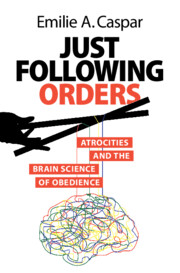Book contents
- Just Following Orders
- Just Following Orders
- Copyright page
- Contents
- Figures
- Preface
- Acknowledgments
- Introduction: Understanding Genocide as a Means to Prevention
- Chapter 1 Listening to the Perpetrators of Genocide
- Chapter 2 A Brief History of the Experimental Research on Obedience
- Chapter 3 How Do We Take Ownership over and Responsibility for Our Own Actions?
- Chapter 4 Moral Emotions under Obedience
- Chapter 5 Just Giving Orders? In the Brains of Those Who Command
- Chapter 6 Desolation Is Everywhere
- Chapter 7 Conclusion: How Ordinary People Stand Up against Immorality
- Epilogue: A Hopeful Horizon
- References
- Index
Chapter 2 - A Brief History of the Experimental Research on Obedience
Published online by Cambridge University Press: aN Invalid Date NaN
- Just Following Orders
- Just Following Orders
- Copyright page
- Contents
- Figures
- Preface
- Acknowledgments
- Introduction: Understanding Genocide as a Means to Prevention
- Chapter 1 Listening to the Perpetrators of Genocide
- Chapter 2 A Brief History of the Experimental Research on Obedience
- Chapter 3 How Do We Take Ownership over and Responsibility for Our Own Actions?
- Chapter 4 Moral Emotions under Obedience
- Chapter 5 Just Giving Orders? In the Brains of Those Who Command
- Chapter 6 Desolation Is Everywhere
- Chapter 7 Conclusion: How Ordinary People Stand Up against Immorality
- Epilogue: A Hopeful Horizon
- References
- Index
Summary
This chapter shows how human obedience is captured in an experimental setup, and how such research methodology can help us understand how people can comply with orders to hurt another person on a neurological level. By reviewing past experimental research, such as the rat decapitation study of Landis, the studies of Stanley Milgram on destructive obedience, and the Utrecht studies on obedience to non-ethical requests, this chapter shows that under certain circumstances, a majority of individuals could be coerced into inflicting physical or psychological harm on others at levels generally deemed unacceptable, even without any tangible social pressures such as military court or job loss. The chapter also describes a novel method where people can administer real painful electric shocks to someone else in exchange for a small monetary reward, and describes how such a method allows neuroscience investigations that would focus on the neural mechanisms associated with obedience.
- Type
- Chapter
- Information
- Just Following OrdersAtrocities and the Brain Science of Obedience, pp. 57 - 86Publisher: Cambridge University PressPrint publication year: 2024



